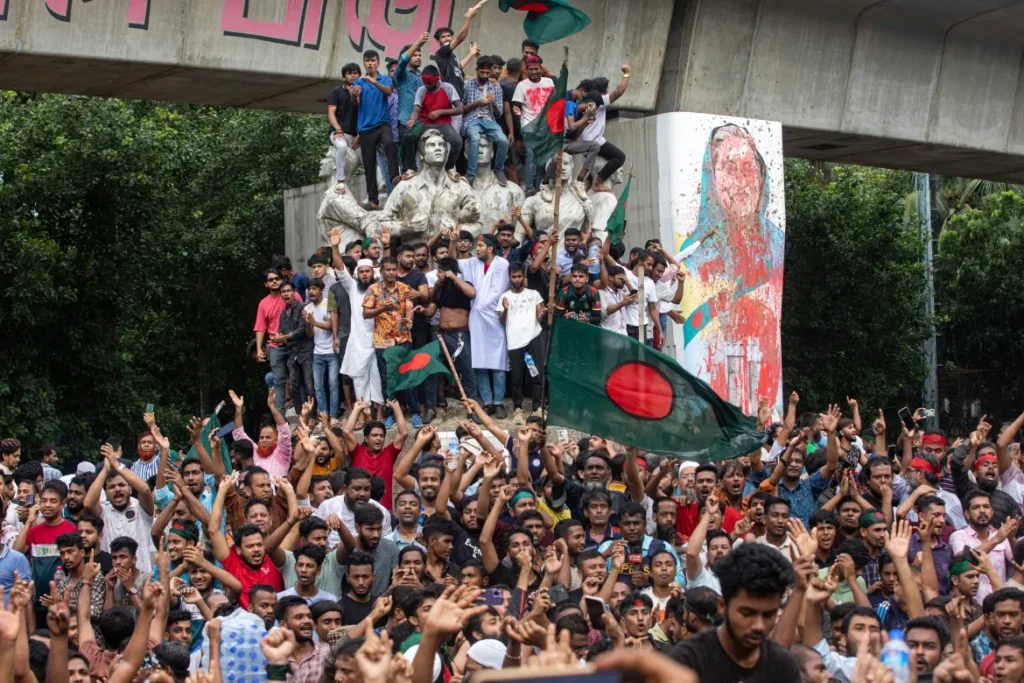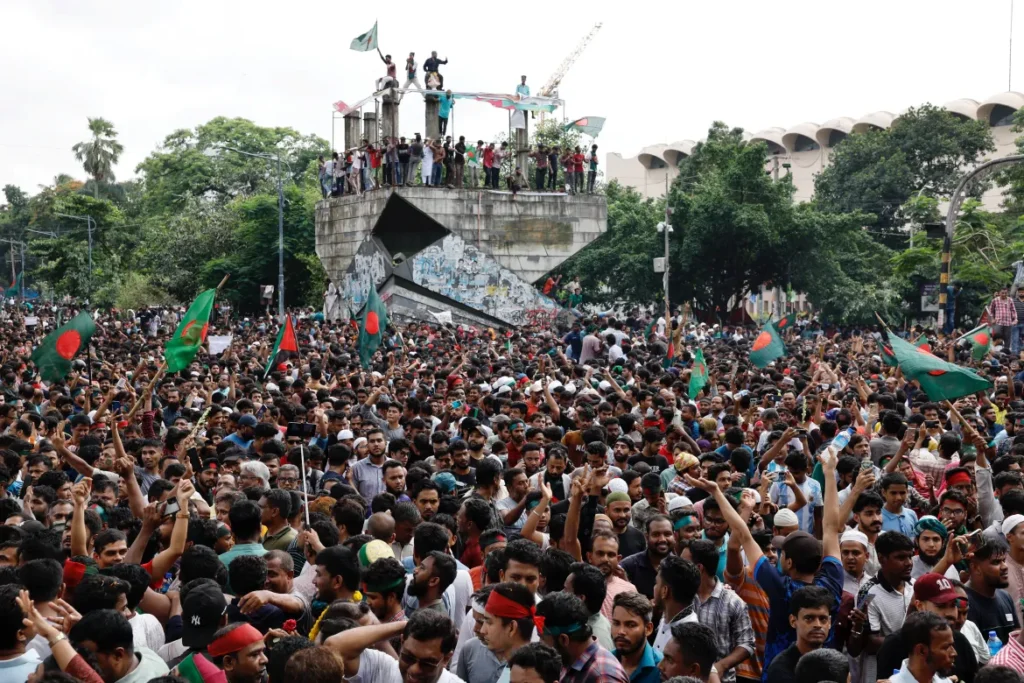
Introduction
In a stunning turn of events, Bangladesh’s Prime Minister Sheikh Hasina has resigned, leaving the nation in turmoil. Her son, Sajeeb Wazed Joy, exclusively informed India Today TV that she is “done with Bangladesh.” This article delves into the details of this unprecedented situation and explores its implications for the country’s political landscape.
The Departure and Public Reaction
Table of Contents
ToggleHours after escalating clashes between police and anti-government protesters resulted in over 300 deaths, including more than 90 on a single Sunday, Sheikh Hasina stepped down. Reports of her resignation circulated before Bangladesh Army Chief General Waqar-uz-Zaman confirmed the news. Crowds poured onto the streets, celebrating her fall from power. The suddenness of her departure caught many by surprise, leaving citizens and international observers alike questioning what lies ahead.

The Quota System and Public Unrest
What began as peaceful student demonstrations against civil service employment quotas for descendants of the nation’s 1971 war of independence spiraled into a nationwide campaign of protest and civil disobedience. Hundreds of thousands of protesters took to the streets, swelling to millions by Monday. Their demand: Sheikh Hasina’s ouster. The contentious quota system implemented by the Hasina government, which reserves 30% of jobs for the families of veterans of the liberation struggle, became the main source of resentment among the populace. As agitated demonstrators scaled the statue of Sheikh Mujibur Rahman, the founder of Bangladesh and Hasina’s father, and smashed it with hammers, the unpredictable nature of history unfolded before our eyes.
The Military’s Role and Political Uncertainty
Faced with the prospect of a bloody confrontation, the military acted swiftly. Hasina’s defiance and accusations that the demonstrators were “terrorists” did not deter the public’s anger. The Awami League party’s position became untenable, leading to her effective ousting. As dawn breaks, the curfew lifts, and the country awaits its next chapter, questions abound. What will the interim government look like? Will justice be served for the lives lost during the weeks-long protests? And most importantly, what lies ahead for Bangladesh?

Khaleda Zia’s Release and Rivalry
As Sheikh Hasina stepped down, Bangladesh President Mohammed Shahabuddin ordered the immediate release of Khaleda Zia, the chairperson of the Bangladesh Nationalist Party (BNP). Zia, who served as prime minister three times since 1991, shares a long-standing rivalry with Hasina. Their political tug-of-war has defined Bangladesh’s recent history, with each leader taking turns at the helm. Zia was previously sentenced to 17 years in prison for corruption but is now free due to the changing political landscape. Her return to the scene adds another layer of complexity to the country’s future.
An Uncertain Path Forward
As the dust settles, Bangladesh stands at a crossroads. The departure of Sheikh Hasina, who ruled the strategically positioned country in South Asia since 2009, leaves a void. The main opposition Bangladesh Nationalist Party (BNP) of Khaleda Zia and its supporters now have an opportunity to shape the nation’s destiny. The world watches closely, wondering whether stability or further upheaval awaits. One thing is certain: Sheikh Hasina’s resignation marks the end of an era, but what follows remains uncertain.
What are the potential consequences for Bangladesh’s economy?
1.Global Uncertainty and Commodity Prices:
Bangladesh has shownresilience in its economic recovery from the COVID-19 pandemic. However, new challenges arise due to global uncertainty, particularly the war in Ukraine.
Rising global commodity prices, driven by the conflict, may lead to higher inflation and a current account deficit in Bangladesh1.
The war’s impact on fuel prices could prompt the country to reduce reliance on fuel imports and transition toward green, resilient growth.
2.Macroeconomic Challenges:
Recent months have forced Bangladesh out of its earlier macroeconomic comfort zone. Stability has deteriorated due to domestic and external challenges2.
The country faces both political unrest and economic vulnerabilities.
Political Crisis and Economic Fragility:
Bangladesh’s ongoing political crisis poses a “high risk” to its fragile economy. An entrenched oligarchy of political elites contributes to the economic downfall3.
The country must carefully plan monetary and fiscal policies to counter external shocks and protect vulnerable populations while fostering inclusive growth.
In summary, Bangladesh faces a delicate balancing act as it navigates economic challenges amid global uncertainties and internal political dynamics. The government’s response and structural reforms will be crucial for sustainable and inclusive growth.
“More Details on Specific Sectors Affected by the Crisis in Bangladesh”
1. Transport and Supply Chains
The countrywide road-rail-waterway blockade imposed by the opposition has disrupted supply chains, significantly increasing transport costs.
Small traders face challenges in bringing goods to markets due to limited truck availability and rising prices.
2. Banking Sector and Loan Defaults
The banking sector faces a crisis due to widespread loan defaults. High default rates have weakened financial institutions, affecting credit availability for businesses and individuals.
Policy paralysis exacerbates the situation, hindering necessary reforms.
3. Energy Sector and Resource Mismanagement
Resources in the energy sector are mismanaged, leading to inefficiencies and waste. The cost of energy production remains high, affecting industrial productivity and competitiveness.
Addressing energy-related challenges is crucial for economic stability.
4. Foreign Investment and Diversification
Both the ruling Awami League and the opposition seek greater foreign investment.
Sectors like infrastructure, renewable energy, pharmaceuticals, agriculture, leather, auto parts, and ICT products are potential areas for growth.
Diversifying the economy away from traditional sectors is essential for resilience.
In summary, the crisis impacts multiple facets of Bangladesh’s economy, necessitating urgent reforms and strategic planning. If you have any further questions or need additional information, feel free to ask!

Recent Economic Performance Indicators in Bangladesh
1. GDP Growth:
– In fiscal year 2022 (ended June 2022), Bangladesh’s GDP growth reached 7.1%.
– The services sector played a significant role in driving this growth, while the industry sector experienced a slight deceleration.
2. Inflation:
– Average inflation in FY2022 was 6.2%, influenced by higher global commodity prices and local currency depreciation against the US dollar.
– Notably, the Consumer Price Index (CPI) rose by 9.02% in 2022-23, marking the highest average inflation rate in 12 years.
3. Fourth Quarter Growth:
– In the fourth quarter of 2022, Bangladesh’s GDP expanded by 7.25% compared to the same period in the previous year.
These figures provide insights into Bangladesh’s economic trajectory, but ongoing developments and policy responses remain critical. If you need further details or have additional questions, feel free to ask!
You may Also Like hover over images

“Six months after launching a supercomputer with 1,528 H100 AI GPUs, NVIDIA’s CEO announces in Denmark its AI-era impact.”

The Legacy of Ratan Tata: A Visionary Leader passed away Who Changed India Forever

Bhiwani, Assembly of Haryana Election Results: Live Updates for 2024

JioCinema’s Power Move: YouTube India Head Ishan Chatterjee Joins as Chief Business Officer!

Women’s Twenty20 World Cup 2024: India vs. Pakistan Live Score: IND-W 8/0 (2); Shafali, Smriti start 106-run chase vs. PAK-W



